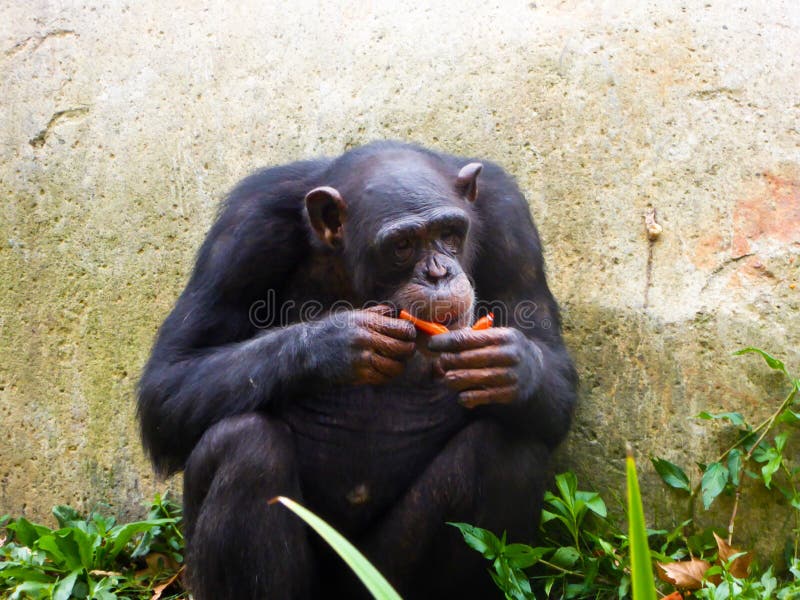

N., Mundry, R., Nakamura, M., Pruetz, J., Pusey, A. L., Hohmann, G., Itoh, N., Koops, K., Lloyd, J. L., Boesch, C., Fruth, B., Furuichi, T., Gilby, I. (2016), Spatio-temporal complexity of chimpanzee food: How cognitive adaptations can counteract the ephemeral nature of ripe fruit. Janmaat, K.R., Boesch, C., Byrne, R., Chapman, C.A., Goné Bi, Z.B., Head, J.S., Robbins, M.M., Wrangham, R.W. Proceedings of the National Academy of Sciences, 111, 16343 - 16348. Wild chimpanzees plan their breakfast time, type, and location. Chimpanzees are omnivorous frugivores that eat both plant and animal products with a high preference for fruits. Janmaat, K., Polansky, L., Ban, S., & Boesch, C. Taï chimpanzees use botanical skills to discover fruit: what we can learn from their mistakes. and chimpanzees focus very strongly on fruit in the diet, eating some. Of the great apes, the closest relative of the Chimpanzee is the bonobo. Other members of the Hominidae family include orangutans, gorillas, bonobos, and humans. Among plant parts eaten, fruits contributed the greatest percentage of fresh weight (18) in. ter understanding of the probable food habits and dietary niche of early humans. By Animals Network Team The Chimpanzee is a member of the Hominidae family, also known as the great apes. (2017b), Exploitation of underground bee nests by three sympatric consumers in Loango National Park, Gabon. Chimpanzees utilized 42 plant species for fruits, leaves, and piths. The bark-eating habits in primates, with special reference to their status in the diet of wild chimpanzees. Extraction of honey from underground bee nests by central African chimpanzees ( Pan troglodytes troglodytes) in Loango National Park, Gabon: Techniques and individual differences. Therefore, bees did not appear to be a fallback food for the Gishwati chimpanzees. American journal of primatology, 69(5), 487–502. Fruit availability, chimpanzee diet, and grouping patterns on Rubondo Island, Tanzania. This is comparable to the quantity of meat eaten by modern human societies whose members forage when other food sources are scarce. Another is that new evidence on active predation by nonhuman primates, notably baboons and chimpanzees (Teleki, 1975), and on widespread omnivory among living. What does a chimpanzee need? Using natural behaviour to guide the care of captive populations. In conclusion, chimpanzees are omnivores animals though the higher percentage of their diet consists of vegetables.Based on the accounts of researchers working with the Rekambo Community in the Loango National Park on a daily basis. Infant chimpanzees especially the orphaned babies can feed on milk this can be seen at Tchimpounga sanctuary. Chimpanzees have also been seen consuming honey.Ĭhimpanzees in Guinea, West Africa have been observed taking palm wine, the natural sugars in pal nuts ferment with tropical heat creating alcohol beverage that they take by creating vessels out of leaves.

Chimpanzees are also seen hunting occasionally for invertebrates like pattas monkeys, yellow baboons, red tailed monkeys, western red colobus monkeys and small antelopes like duikers.Ĭhimpanzees always spend most of their day eating, early in the morning when chimpanzees wake up they always eat a variety of food depending on the availability near them and after midday they start being selective by eating more ripe fruits and leaves that contain a lot of water.Ĭhimpanzees at Gombe national park in Tanzania have been observed eating Apilia mossambicensis plant which helps them to deal with parasites in their digestive systems, chimpanzees consume a lot of figs which is their source of energy. During hunting sessions the whole chimpanzee family always participates by others chasing the monkey, some block the monkey and others ambush it but once he prey has been caught the whole group shares the meat.Ĭhimpanzees sometimes use leaves as bowels for drinking water and they also use stones for breaking hard nuts. Bonobo chimpanzees also love fruits with about 57% of their diet composed of fruits. Chimpanzees are omnivores animals that need a lot of nutrients in their diet that is why they eat up to 100 types of plants on top of supplementing their diets with meat, insects, ants, bird eggs, pith, bark, buds and termites though the always prefer vegetables to other foods.Ĭommon chimpanzees always prefer to eat fruits other than any other diet but in case of no availability they can eat leaves, shoot, stems, flowers, seeds, resin and bark.


 0 kommentar(er)
0 kommentar(er)
